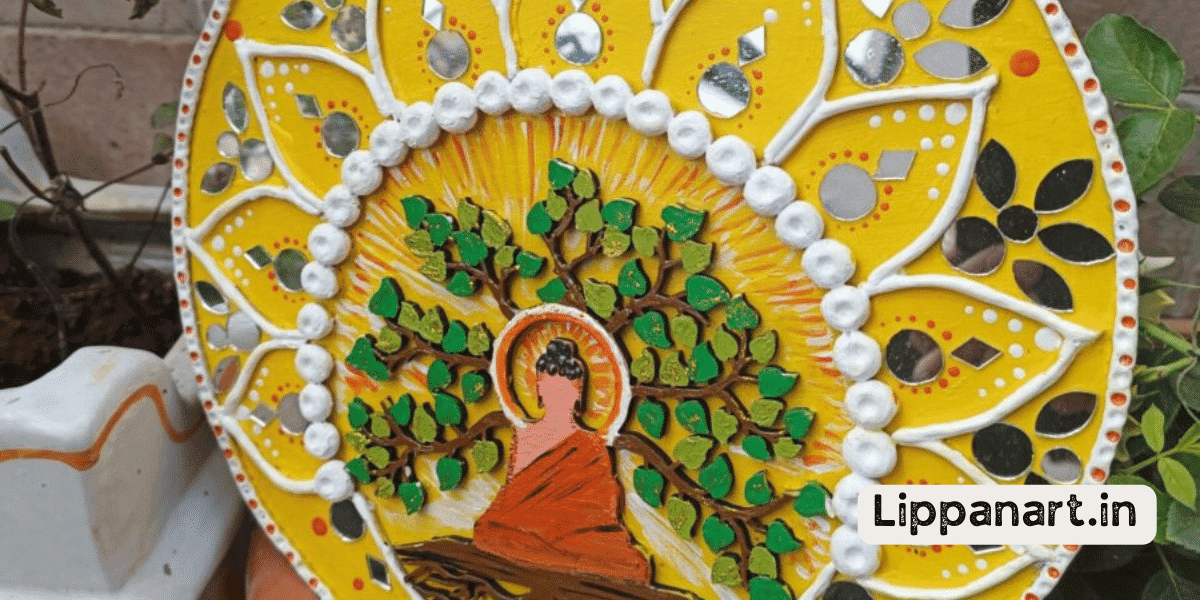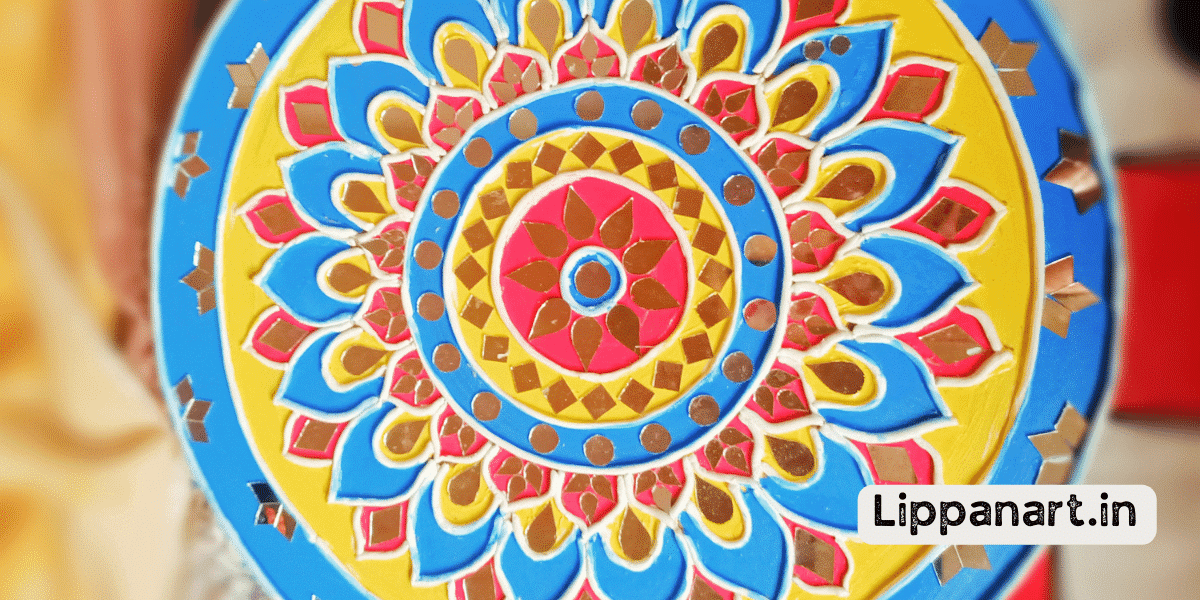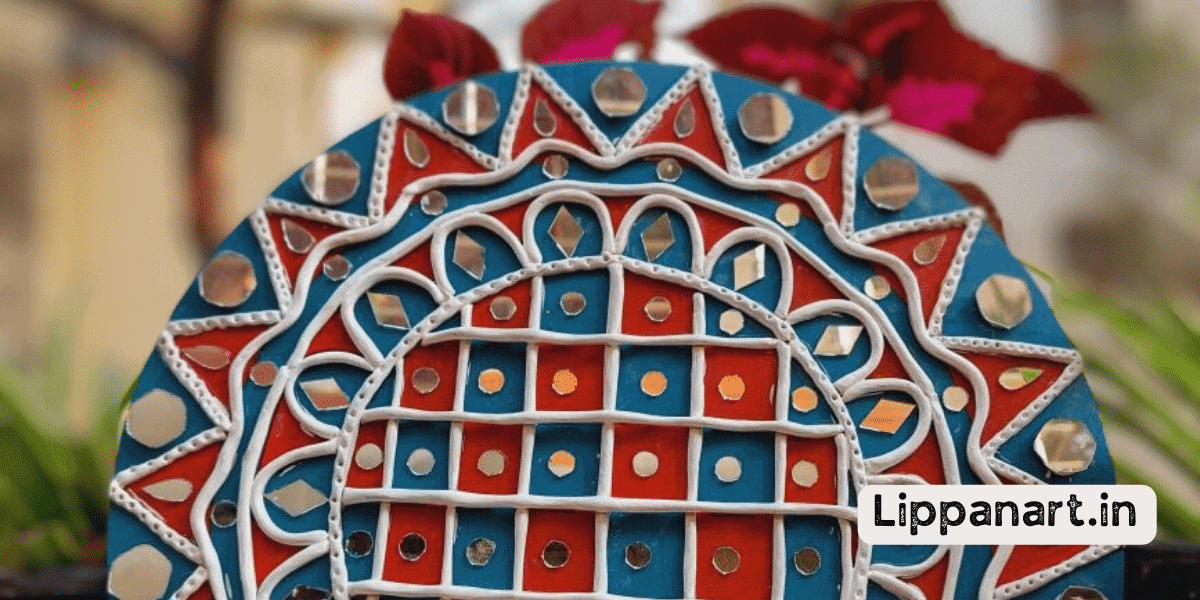You may think protecting lippan art is too difficult or labour-intensive, but with the right tools and knowledge, you can maintain the beauty and vibrancy of this unique art form.
Learn how to preserve lippan art for long-lasting enjoyment. We’ll review placement and environment, sealing and coating, cleaning and maintenance, avoiding direct sunlight and more.
Join us to learn how to protect lippan art for innovation in your home.
Placement and Environment
You’ll want to ensure you place the lippan art in an environment that won’t expose it to too much humidity or heat. This is essential to keep it looking vibrant and alive. While the art is resilient, too much moisture and heat can cause it to crack and fade. Therefore, when selecting a placement for the lippan art, ensure it’s in a cool, dry area.
It’s crucial to select an area that won’t be directly exposed to sunlight, as this may lead to the artwork fading or discoloring. When it comes to the environment, make sure it won’t cause harm to the art. If you’re placing it in a room, consider the type of furniture, carpets, and other items nearby. Any items with sharp edges or abrasive surfaces could damage the art. Additionally, if the art is placed near a window, use a sheer curtain to prevent direct sunlight from hitting it.
Sealing and Coating
You’ll want to seal and coat your surface to ensure it lasts. This is the key to protecting your lippan art for years to come. By applying a protective layer, you preserve the vibrant colours, intricate designs, and delicate details you worked so hard to create.
Here are some options to consider when sealing and coating your lippan art:
- A dammars varnish that will give your lippan art a soft matte finish
- A canvas varnish that will provide an extra layer of protection
- Oil gilding that will give your art a luxurious and long-lasting finish
- Lacquer to add a glossy finish and vibrant colours
- Wood sealers that will ensure your art is water and dust resistant
Each option will give your lippan art the protection it needs to last for decades.
As you choose the best solution for your project, remember to consider the environment, the amount of traffic it will receive, and any other factors that might affect the longevity of your art.
With the right sealant and protective coating, you can ensure your lippan art will be admired for years.
Cleaning and Maintenance
Properly cleaning and maintaining your lippan artwork is essential for preserving its longevity. To ensure your artwork remains vibrant and beautiful, it is important to understand the materials used to create it.
Different cleaning products and techniques can be used depending on the surface type. For example, an artwork with a glossy finish may require a gentle cleaning with a soft cloth and a mild cleaning solution. On the other hand, artwork with a matte finish may require a slightly abrasive cleaning product and a stiff brush.
Regardless of the technique, following the manufacturer’s instructions when using any cleaning product is important. Additionally, cleaning the artwork regularly and avoiding harsh chemicals or solvents is important, as these can damage the artwork.
Avoiding Direct Sunlight
If you want your artwork to retain its vibrancy and beauty, keeping it away from direct sunlight is crucial. Here are a few ways to protect your lippan art:
- Keep it out of direct sunlight: To avoid colour fading, hanging the item in an area where it is not directly exposed to sunlight is recommended.
- Use sheer curtains: For effective filtering of direct sunlight that enters through windows, it is advisable to opt for sheer curtains.
- Please keep it away from heat: Direct heat can cause the colours to become dull or fade, so keep lippan art away from any heat sources.
- Use UV-protective glass or acrylic: If you display your lippan art in a frame, make sure to use glass or acrylic with UV protection to filter out the sun’s harmful rays.
- Move it around: Move your lippan art to different places in your home occasionally so that it doesn’t get too much direct sunlight.
Temperature and Humidity Control
To ensure your lippan artwork lasts for years, it’s important to maintain the correct temperature and humidity levels. To keep your artwork as vibrant and vibrant as when you first created it, you’ll need to ensure that the environment in which it is stored is optimal. Too high temperatures and humidity can cause the colours to fade or the paper to warp, while too low temperatures and humidity can cause cracks in the lippan.
To properly store lippan art, it is recommended to maintain a temperature range of 65-75 degrees Fahrenheit and a humidity level of 40-60%.
It’s important to check the room temperature and humidity levels where your lippan art is stored regularly. If you find that the temperature is too high or the humidity is too low, it’s important to take corrective action. You can purchase a thermostat to regulate the temperature or invest in a dehumidifier to ensure the humidity is at the correct level. You can also open and close windows and doors to control the environment.
Handling with Care
Taking care of lippan art is important, so handle it gently and avoid rough contact. Take your time with two hands when picking up or moving the piece. Ensure your hands are clean and dry and the area is free of debris or sharp items.
To keep your lippan art looking its best, here are some tips for handling it with care:
- Inspect the piece regularly for damage
- Handle only the edges, never the face of the piece
- Avoid rubbing or touching the surface directly with your hands
- Refrain from using any harsh cleaning agents
- Always store the piece away from direct sunlight and mirrors
Storing and handling lippan art carefully is essential to preserving its beauty and longevity. Taking the time to clean and secure the piece properly will ensure it stays in its original condition for many years. Following a few easy steps, you can safeguard your lippan art and relish it for years.
- Editor’s Choice
- Best Seller
- Amazon Choice
Protective Framing
Now that you know how to handle your lippan art carefully, let’s discuss the next step in preserving its beauty: protective framing.
Indian folk art is delicate, and acrylic paints make it even more susceptible to environmental damage. A good frame is essential to keeping it safe.
It would help if you looked for a frame with UV-filtering acrylic glazing to protect against fading and discolouration. Look for frames with acid-free backing and spacers to prevent the art from coming into contact with the glazing. This will keep the art from sticking to the glazing due to moisture.
Lastly, make sure you choose a frame that is tight enough and tight enough. If it’s too tight, it can cause the art to bend, and if it’s too loose, it can cause the art to move around and get damaged.
Regular Inspections
To keep your folk art safe, it’s important to inspect it regularly. This involves thoroughly checking the artwork’s condition and doing any necessary repairs immediately. You should also check for any signs of wear and tear and use the right touch-up materials.
Here’s what you’ll need to inspect:
- The clay surface: check for cracks or chips and ensure it is intact and dirt-free.
- The painting mediums: look for any signs of fading or discolouration and make sure they are still vibrant.
- Brushes: make sure they are in good condition and not worn out.
- The frame: check for any warping or damage and make sure the frame is secure.
- The glass: make sure it is still clean and clear.
Regular inspections are key to keeping your lippan art in tip-top shape. Investing in quality materials and being mindful of the conditions your artwork is in can ensure your folk art pieces are always looking their best. You can keep your lippan art safe and beautiful with some care and attention.
Repairs and Restoration
If you notice any damage to your folk art, it’s important to repair or restore it immediately. Lippan art requires a delicate touch and creative problem-solving to preserve it for future generations. Repairing and restoring this unique artwork requires combining traditional techniques and modern innovations.
| Traditional | Modern | Innovation |
|---|---|---|
| Patches | Adhesives | Experimentation |
| Embroidery | Lightweight materials | Collaboration |
| Stitching | Protective coatings | Adaptation |
| Replacement pieces | Re-creation | Preservation |
| Artistic repair | Digital restoration | Inclusivity |
Repairs and restoration of lippan art involve a combination of materials and techniques. Traditional methods such as stitching and embroidery should be used, as these are the most likely to preserve the original look and feel of the art. Additionally, modern materials such as adhesives and protective coatings can be used to restore the structural integrity of the art.
In some cases, repairs may involve replacing pieces of the artwork entirely. Here, it is important to ensure that the replacements are done in a way that maintains the original integrity of the piece. Additionally, digital restoration techniques can bring a faded or damaged piece back to life.
Innovation is essential when it comes to preserving lippan art. Experimentation and collaboration with fellow artisans can lead to new techniques and materials that can be used to repair and restore artwork. Adapting to changing environments and trends can also help ensure the art’s longevity. Finally, inclusivity is key to preserving the culture and tradition of lippan art.
Storing During Transitions
When transitioning lippan artwork, it’s important to ensure it is stored properly to keep it safe and secure. To ensure your Indian artworks are secure during a move or transition, consider these five tips:
- Invest in quality products for an added layer of protection. Choose bags and containers that are designed to protect fragile items.
- Avoid using regular boxes or bags that may not be strong enough to protect the artwork.
- Keep the artwork away from moisture, dirt, and other elements.
- Label the boxes and bags for easy identification and reference.
- Take extra care when moving lippan artworks. Ensure that you use the proper materials and techniques to avoid damage.
Storing lippan artwork during a transition is essential for its preservation and security. Invest in quality products, avoid using regular boxes or bags, keep the artwork away from moisture, dirt, and other elements, label the boxes and bags, and take extra care when moving them. By following these steps, you can ensure your Indian artworks are safe and secure during a transition.
Using UV Filters
UV filters are important in preserving lippan artworks and protecting them from damage. By using filters on acrylic paintings, you can reduce the amount of UV radiation the work is exposed to. This helps to protect the artwork’s colour selection and prevent fading.
UV filters are also beneficial for those working in outdoor conditions, as they help to protect from the sun’s harsh rays. When selecting a UV filter, make sure to choose one that is suited to the type of artwork you plan to create. This will ensure the filter provides maximum protection and helps your artwork stay vibrant.
The installation process is simple and should only take a few minutes. To complete the installation, follow the instructions included with the filter. After installation, you can relax knowing that your artwork is safeguarded against fading and other types of damage.
Using UV filters is an effective way to ensure your lippan artworks stay vibrant and safe from harm.
Avoiding Moisture Exposure
Keeping your lippan artworks away from moisture exposure is important to ensure their longevity and vibrancy. To avoid moisture exposure and keep your lippan art looking great:
- Create a dust barrier around your artwork.
- Keep the area around your artwork dry and clean.
- Be mindful of humidity levels in the room.
- Vacuum the area around your artwork.
- Open windows to let in fresh air.
When protecting your lippan artwork from moisture, it’s important to take preventative measures. Dust particles can act as a shield against moisture and dirt particles, so place a dust barrier around your artwork.
Additionally, keeping the area around your artwork dry and clean is essential for maintaining its vibrancy. You should also keep an eye on the humidity levels in the room and make sure they’re not too high.
Vacuuming the area around your artwork is also a great way to remove any dirt particles that may be present. Finally, try to open the windows occasionally to let in fresh air and keep the environment around your artwork clean.
- Editor’s Choice
- Best Seller
- Amazon Choice
Pest Prevention
To prevent pests from damaging your artwork, regularly check the area for any signs of infestation and take action if necessary. To keep pests out, apply a protective layer of cow dung to the walls and floors. For the air-drying clay, use it to create an additional barrier between the art and the pests. If pests are discovered, use chemical cleaning products to eliminate them, but follow the instructions carefully.
You can also employ natural pest control solutions, such as using plants or herbs as natural repellents. Additionally, be sure to keep the area clean and free of debris. This will further mini the chances of pests invading the area. If there is an ongoing issue, consider contacting a professional pest control service for help.
In addition, try to keep the artwork away from areas prone to pests, such as a damp or dark room corner. Doing so will reduce the risk of infestation. Finally, regularly inspect the area to prevent any potential damage.
Educating Onlookers
Educating onlookers about the history and techniques of lippan art can help to ensure its continued appreciation. Discovering the unique shapes, colours, and culture of lippan art can be a captivating experience.
- Uncover the history of lippan art and its various forms.
- Explore the wide range of shapes, colours, and textures used in lippan art.
- Watch and learn from artisans as they create intricate designs.
- Learn about the cultural significance of lippan art and how it is used in Indian culture.
- Discover how to preserve and protect lippan art for generations to come.
Documentation and Record-Keeping
Documenting and recording lippan artwork is essential for its continued appreciation and celebration. You can help protect this traditional Indian folk art form by taking simple steps.
First, ensure that the artwork is framed and the colours are protected with a coat of varnish. This will help preserve the artwork’s design and colours and prevent further damage.
Additionally, it’s important to document the artwork’s history, including the artist’s name, the date it was created, and any other relevant information. This will help to ensure that the artwork is properly attributed and appreciated.
Frequently Asked Questions
How Often Should I Inspect My Lippan Art?
You should inspect your lippan art regularly to ensure its longevity. Aim to check it at least once every few months to look for any signs of damage. Be proactive and use innovative methods to protect it.
What Are the Best Materials to Use for Protective Framing?
You’ll want to use acrylic glass, archival mat board, and acid-free foam core to protect your artwork. Did you know these materials have proven 99% effective in preserving artwork? Invest in a good framing system for optimal protection.
Is It Safe to Move Lippan Art From One Place to Another?
Yes, it’s safe to move lippan art! Take the necessary precautions to ensure its safety during transport, and you’ll be able to enjoy its beauty in a new location. Innovate with care, and your artwork will thrive.
How Do I Know if My Lippan Art Needs Repairs or Restoration?
“Look before you leap” – inspect your lippan art regularly for signs of damage. Use innovative technologies to detect hidden faults and seek professional advice if needed. Keep your lippan art safe, and it will remain beautiful for years.
How Can I Tell if My Lippan Art Is Being Affected by Pests?
Look for signs of pests like holes, droppings or webs. If you find any, take immediate steps to protect your lippan art.














